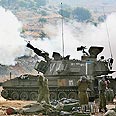
IDF forces in north (Archive photo)
צילום: רויטרס
UN: Million unexploded cluster bombs could be in Lebanon
Organization’s demining expert says, ‘Situation in south Lebanon now, as a result of 34 days of bombing, is that there is extensive unexploded ordnance lying all over the place’; Adds: Bomblets, half the size of a can of soda, are lying in people’s houses, gardens, on the street and on farmland
Up to a million unexploded cluster bombs fired by Israel could be in south Lebanon, nearly three times as many as previously estimated, UN demining experts said Tuesday.
Israel has not responded to repeated UN requests to hand over detailed information about the cluster bomb strikes, making the task of clearing the bomblets far more difficult, they said.
”The situation in south Lebanon now, as a result of 34 days of bombing is that there is extensive unexploded ordnance lying all over the place,” Chris Clark, the top UN demining official in Lebanon, told a news conference.
The bomblets, half the size of a can of soda, are lying in people’s houses, gardens, on the street and on farmland, he said.
So far, 14 people have been killed and around 90 injured from unexploded ordnance since the Aug. 14 ceasefire according to the United Nations Mine Action Center in Lebanon.
A week ago, the UN put the death toll at 15.
Clark said it could take up to the end of 2007 to clear the cluster munitions.
”The job is not over yet, the casualties will reach a record high this year,” said Col. Wassin Rizq, head of operations of the Lebanese army’s National Demining Office.
The United Nations’ humanitarian coordinator for Lebanon,
David Shearer said a week earlier that Israel could greatly accelerate the overall clearance effort by handing over the
coordinates of where it fired the bombs, but has not done so.
But Clark complained that the Israeli authorities had not responded.
”We’ve not received this so far, we’ve asked and we are waiting,” he said.
No treaties forbid use of cluster bombs
Children are particularly at risk because they are attracted to unfamiliar objects; 2 have been killed and 32 injured.
In one 2-3 meter (6.5-10 foot) radius, 10 cluster bombs were found on the pavement near the entrance to a hospital in the town of Tibnin, Clark said.
The UN Refugee agency said that 200,000 people were still displaced in south Lebanon because it was unsafe to return to their homes and it could take 2 years before they could all do so.
The UN Had previously said it believed 350,000 unexploded cluster bombs were in the south, but now estimates the figure at a million on the basis of Israeli media reports.
So far, UN and Lebanese demining teams have identified 590 cluster bomb strike locations and cleared 30,000 bomblets.
Fired by cannon or dropped from an aircraft, the bombs release hundreds of smaller bomblets in mid-air that are supposed to explode upon impact.
The failure rate in Lebanon, though, was around 30 to 40 percent and the density of cluster munitions in south Lebanon is higher than witnessed in Kosovo or Iraq, the UN said.
Israel has stressed that all the weapons it uses are legal under international law. During the 34-day war, Israel used the bombs to attack Hizbullah fighters, who often use village streets and civilian neighborhoods in southern Lebanon to launch rockets at Israel.
No international treaties or laws specifically forbid the use of cluster bombs, but the Geneva Conventions outline rules to protect civilians during conflict. Because cluster bombs often maim civilians after fighting ends, their use by Israel against targets in Lebanese cities and towns has been criticized by human rights groups.










